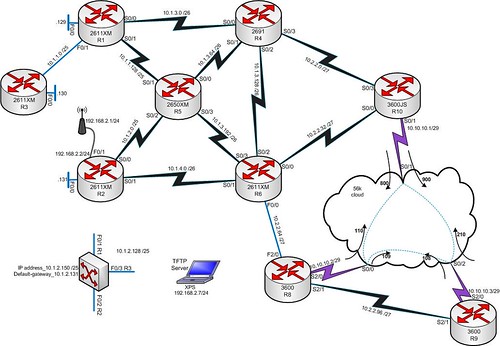ipv6 subnetting/ summarization
in CCNP
have I got this right in my head,
each subnet has it's own subnet ID ?
so say my global prefix was 2001:1111:1111::/48
so when designing a network, R10 is in the middle of the network and to it's left is subnets 1 to 10 binary:
00000000|00000001
00000000|00000010
00000000|00000011
00000000|00000100
00000000|00000101
00000000|00000110
00000000|00000111
00000000|00001000
00000000|00001001
00000000|00001010
then to the right are subnets 11 to 20 binary
00000000|00001011
00000000|00001100
00000000|00001101
00000000|00001110
00000000|00001111
00000000|00010000
00000000|00010001
00000000|00010010
00000000|00010011
00000000|00010100
how would you writ the summarys for those two sets of addresses?
each subnet has it's own subnet ID ?
so say my global prefix was 2001:1111:1111::/48
so when designing a network, R10 is in the middle of the network and to it's left is subnets 1 to 10 binary:
00000000|00000001
00000000|00000010
00000000|00000011
00000000|00000100
00000000|00000101
00000000|00000110
00000000|00000111
00000000|00001000
00000000|00001001
00000000|00001010
then to the right are subnets 11 to 20 binary
00000000|00001011
00000000|00001100
00000000|00001101
00000000|00001110
00000000|00001111
00000000|00010000
00000000|00010001
00000000|00010010
00000000|00010011
00000000|00010100
how would you writ the summarys for those two sets of addresses?
What's another word for Thesaurus?
Comments
-
 dtlokee
Member Posts: 2,378 ■■■■□□□□□□
well 1-10 and 11-20 aren't well suited for a summary, 0-7 would be better because it's a power of 2. The most common mistake people make when summarizing IPv6 is to only write out the bits that are shown and leave out the leading zeros.
dtlokee
Member Posts: 2,378 ■■■■□□□□□□
well 1-10 and 11-20 aren't well suited for a summary, 0-7 would be better because it's a power of 2. The most common mistake people make when summarizing IPv6 is to only write out the bits that are shown and leave out the leading zeros.
2001:1:1::/64
2001:1:1:1::/64
2001:1:1:2::/64
2001:1:1:3::/64
The problem is at first glance you may forget there are 16 bits in each group. You should always remember to write them in blocks of 16 bits even though there are zeros in each group. If you work this out it will summarize to 2001:1:1::/620010 0000 0000 0000 : 0000 0000 0000 0001 : 0000 0000 0000 0001 : 0000 0000 0000 0000 0010 0000 0000 0000 : 0000 0000 0000 0001 : 0000 0000 0000 0001 : 0000 0000 0000 0001 0010 0000 0000 0000 : 0000 0000 0000 0001 : 0000 0000 0000 0001 : 0000 0000 0000 0010 0010 0000 0000 0000 : 0000 0000 0000 0001 : 0000 0000 0000 0001 : 0000 0000 0000 0011
The only easy day was yesterday! -
 aueddonline
Member Posts: 611 ■■□□□□□□□□
isn't the subnet always going to fall somewhere in the 16 bit subnet portion of the address? so you only need to write dowm the 16 bits to work out the summary?
aueddonline
Member Posts: 611 ■■□□□□□□□□
isn't the subnet always going to fall somewhere in the 16 bit subnet portion of the address? so you only need to write dowm the 16 bits to work out the summary?
Good point on the powers of two i'll remember that nugget of gold What's another word for Thesaurus?
What's another word for Thesaurus? -
 aueddonline
Member Posts: 611 ■■□□□□□□□□
how do I put a picture on here that I have in my docs that doesn't have a URL? i'll put a topology up here to refer toWhat's another word for Thesaurus?
aueddonline
Member Posts: 611 ■■□□□□□□□□
how do I put a picture on here that I have in my docs that doesn't have a URL? i'll put a topology up here to refer toWhat's another word for Thesaurus? -
 dynamik
Banned Posts: 12,312 ■■■■■■■■■□
Photobucket, Imageshack, or just throw it up on Flickr or something.
dynamik
Banned Posts: 12,312 ■■■■■■■■■□
Photobucket, Imageshack, or just throw it up on Flickr or something. -
 aueddonline
Member Posts: 611 ■■□□□□□□□□
being a bit retard at this, anyway that's my home lab, i'm going to desgin the ipv6 address scheme tonight i'll post it when i'm done, you can all tell me it's wrong
aueddonline
Member Posts: 611 ■■□□□□□□□□
being a bit retard at this, anyway that's my home lab, i'm going to desgin the ipv6 address scheme tonight i'll post it when i'm done, you can all tell me it's wrong What's another word for Thesaurus?
What's another word for Thesaurus? -
 aueddonline
Member Posts: 611 ■■□□□□□□□□
Link Golbal Prefix Subnet ID
aueddonline
Member Posts: 611 ■■□□□□□□□□
Link Golbal Prefix Subnet ID
R3 - R1 20E1::/64 ::1
R1-R4 20E1::/64 ::2
R1-R5 20E1::/64 ::3
R2-R5 20E1::/64 ::8
R2-R6 20E1::/64 ::9
R4-R5 20E1::/64 ::4
R4-R6 20E1::/64 ::16
R4-R10 20E1::/64 ::17
R5-R6 20E1::/64 ::10
R6-R10 20E1::/64 ::18
R6-R8 20E1::/64 ::32
R8-R9 20E1::/64 ::33
CLOUD 20E1::/64 ::34
this is what i've got so far, I want to be able to summarize at R10, R4 and R6What's another word for Thesaurus?













